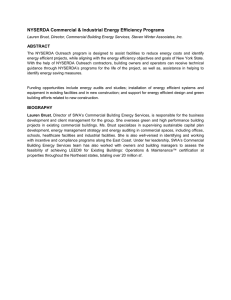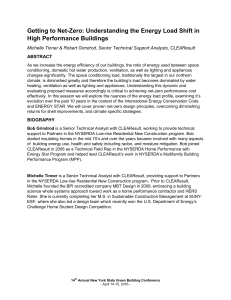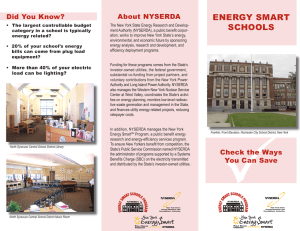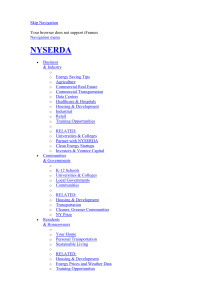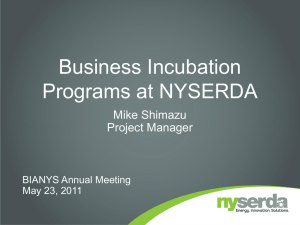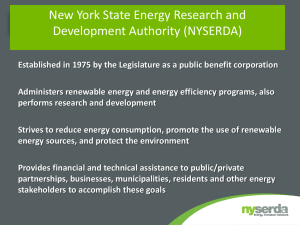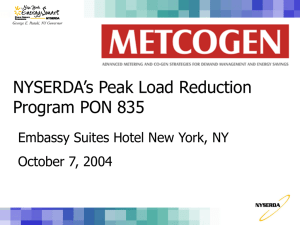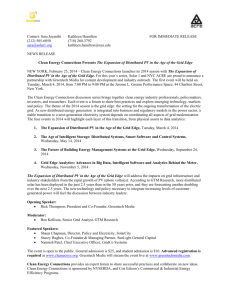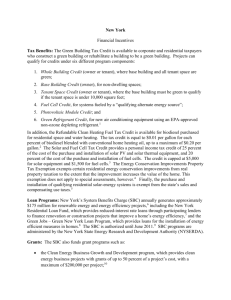Appendix F: Blueprint for an Upper West Side building to switch fuel
advertisement
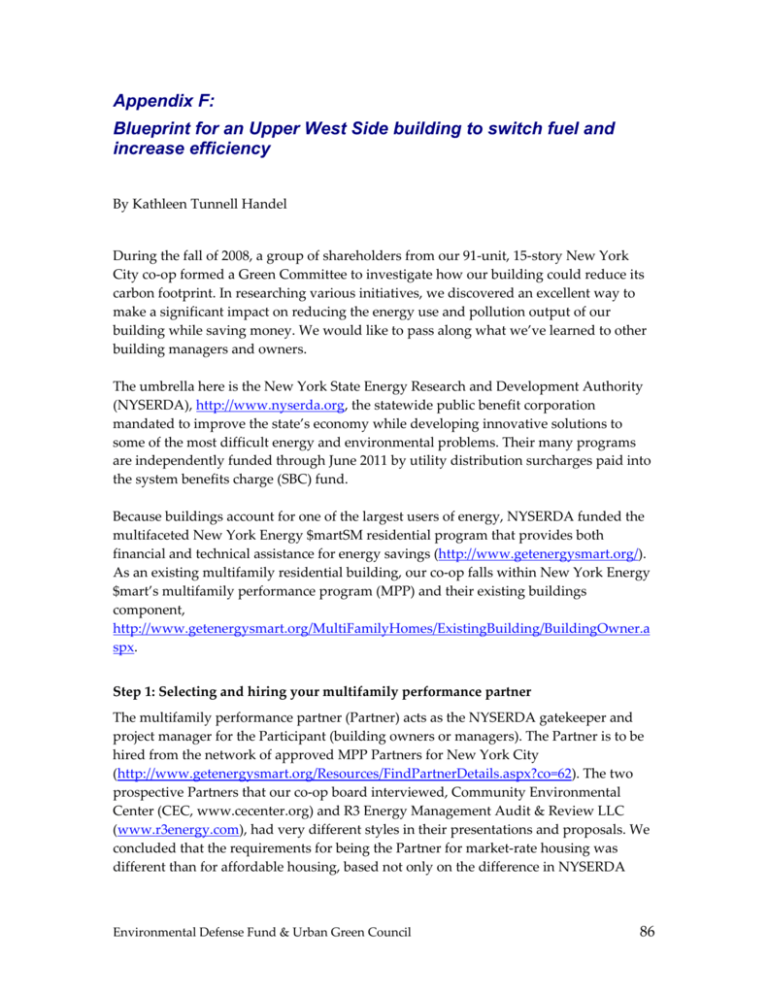
Appendix F: Blueprint for an Upper West Side building to switch fuel and increase efficiency By Kathleen Tunnell Handel During the fall of 2008, a group of shareholders from our 91-unit, 15-story New York City co-op formed a Green Committee to investigate how our building could reduce its carbon footprint. In researching various initiatives, we discovered an excellent way to make a significant impact on reducing the energy use and pollution output of our building while saving money. We would like to pass along what we’ve learned to other building managers and owners. The umbrella here is the New York State Energy Research and Development Authority (NYSERDA), http://www.nyserda.org, the statewide public benefit corporation mandated to improve the state’s economy while developing innovative solutions to some of the most difficult energy and environmental problems. Their many programs are independently funded through June 2011 by utility distribution surcharges paid into the system benefits charge (SBC) fund. Because buildings account for one of the largest users of energy, NYSERDA funded the multifaceted New York Energy $martSM residential program that provides both financial and technical assistance for energy savings (http://www.getenergysmart.org/). As an existing multifamily residential building, our co-op falls within New York Energy $mart’s multifamily performance program (MPP) and their existing buildings component, http://www.getenergysmart.org/MultiFamilyHomes/ExistingBuilding/BuildingOwner.a spx. Step 1: Selecting and hiring your multifamily performance partner The multifamily performance partner (Partner) acts as the NYSERDA gatekeeper and project manager for the Participant (building owners or managers). The Partner is to be hired from the network of approved MPP Partners for New York City (http://www.getenergysmart.org/Resources/FindPartnerDetails.aspx?co=62). The two prospective Partners that our co-op board interviewed, Community Environmental Center (CEC, www.cecenter.org) and R3 Energy Management Audit & Review LLC (www.r3energy.com), had very different styles in their presentations and proposals. We concluded that the requirements for being the Partner for market-rate housing was different than for affordable housing, based not only on the difference in NYSERDA Environmental Defense Fund & Urban Green Council 86 eligibility requirements and financial incentive schedules but also in the building’s ownership structure and decision-making process. The important initial selection of our building’s Partner was based on the positive references from numerous completed projects for buildings similar to ours as well as the level of experience in successfully navigating this complex process in a timely and financially responsible manner. Our building agreed to the preliminary scope of work detailed in R3 Energy’s proposal and contracted with them as our MPP Partner. Step 2: The Partner benchmarks the building’s relative energy consumption and completes the energy audit for the Participants to review their energy-saving options Once NYSERDA approves that the building’s submitted application and participation agreement meets their minimal eligibility requirements, the Partner utilizes the required software benchmarking tool and performs a comprehensive energy audit of the building. That energy audit will be used to compare the building’s current total energy consumption to that of similar multifamily buildings. The Partner then submits the resulting benchmark report and a proposed energy reduction plan (ERP) to the Participant, who reviews all the recommended potential energy reduction measures with their individual overall savings to investment ratio (SIR). Our co-op became interested in working with NYSERDA as we were in the process of evaluating options to replace our aging low-pressure steam boiler. As a very costly expenditure with many technical details to consider, finding out that there was a state program in place that could help pay for us not only to work with a Partner, but also to help pay for the energy-saving projects we chose was a revelation. R3’s initial proposal helped clarify the boiler questions the board had been faced with, such as whether to replace or repair the boiler, stay with oil fuel, have Con Edison run a line in from the street to use natural gas or to choose dual fuel enabling the building to use gas or oil based on cost, and whether to replace but still keep the old boiler as a potential back-up or to remove it altogether. Step 3: The Participant works with the Partner to finalize the energy reduction plan that will achieve their energy reduction target and get NYSERDA approval To be eligible for the available low-cost loans and larger financial incentives, the agreedupon final scope of work needs to reduce the building’s energy performance by 20% and the reduction substantiated over the required period of time. Measures that have historically produced favorable SIRs include replacing the boiler with a dual fuel system, upgrading the building energy management system for heating and installing a master electric meter with apartment submetering for building bulk-rate electricity purchasing. Our building is also reviewing options including energy-efficient lighting, a green roof Environmental Defense Fund & Urban Green Council 87 and photovoltaic or solar panels. Step 4: After the ERP is approved, the Partner helps bid the project out to any required third parties, such as the system’s engineer and any contractors, while helping apply for the low-interest $martSM Loan and coordinating receipt of the first financial incentive payment Bidding the project out and hiring and monitoring experienced and reliable contractors for the design, engineering and completion of the project is the next stage where the Partner is an invaluable aid to the Participant. The Partner also helps develop any financing strategy, including applying for a loan through the New York Energy $martSM Loan Fund (http://www.nyserda.org/loanfund). This program provides an interest rate reduction off a participating lender's normal loan interest rate for a term up to ten years on loans for certain energy efficiency improvements and renewable technologies. NYSERDA brochures: Multifamily Performance Program Overview: www.getenergysmart.org/Files/Brochures/MultifamilyOverview.pdf MPP Existing Buildings How To Participate Guide With Financial Incentives Table: www.getenergysmart.org/Files/Brochures/ExistStepByStepFactSheet.pdf What To Expect From Your MPP Partner: www.getenergysmart.org/Files/Multifamily/MarketingMaterials/WhatToExpect8-2807.pdf Energy $martSM Loan Fund: http://www.nyserda.org/loanfund/loanfundbrochure05.pdf Environmental Defense Fund & Urban Green Council 88
